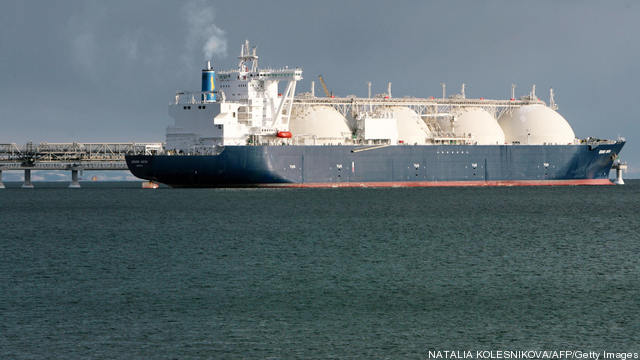 Countering the Russian incursion into Crimea, the House Energy and Power Committee is debating multiplying American LNG exports, and sending shale gas in liquid form to countries overseas, a move that consultants say will raise US electricity prices.
Countering the Russian incursion into Crimea, the House Energy and Power Committee is debating multiplying American LNG exports, and sending shale gas in liquid form to countries overseas, a move that consultants say will raise US electricity prices.
A knock-on effect of sending more shale gas abroad is that US electricity companies that have gas-fired power plants will begin to compete in earnest with foreign electricity companies for the gas.
Japanese electricity companies pay four times what American companies pay for natural gas, last fall paying $15.30/MMbtu when some American companies were paying as low as $3.68/MMbtu.
As a result of the competition between more electricity generators for natural gas, gas prices will spike alongside household electricity bills in the US.
Increased LNG exports will cause US states to see higher gas prices depending on local demand levels, said Gordon Pickering, Director of natural gas consulting firm, Navigant.
How much the country’s combined LNG exports will hike gas prices regionally and nationally was the question Navigant answered for six LNG export plants using its own modeling software, as required of plant operators by FERC export laws. It modeled the impact of different plants for two scenarios, through 2035 and 2045.
Several of the LNG export facilities modeled caused natural gas prices to spike as much as 10% over short periods. Price increases in local markets averaged 5%.
The highest differences in post-exports natural gas prices were seen near to natural gas trading hubs. Major hubs are situated in Massachusetts, New York, Pennsylvania, Illinois, Louisiana, Texas, Arizona, California, and Washington.
Higher average gas prices would lead to higher average wholesale electricity prices. Average wholesale electricity prices may increase 5-6% in the run up to 2045, increasing 12% during the high gas price spikes.
Wholesale electricity prices are paid by electric utilities. Increases in these costs are likely to be wrapped up in household bills following a FERC approval process, according to Tyson Brown, Project Lead at the Energy Information Administration.
New natural gas demand sources
The strong correlation between gas and electric prices will grow in coming years because of the growing place of natural gas as fuel for power plants.
The amount of gas-fired power in the US will increase 16% by 2040, according to the Energy Information Administration.
Power generators are swapping out the conventionally-operated, ‘dirty’ coal plants that will shut down in 2015 under the Mercury Air Toxics Standards Rule with new gas-fired power plants.
President Obama’s recently announced Climate Action Plan, which seeks to curb carbon emissions and favors lower-emissions natural gas, could also increase the number of gas-fired power plants.
More hungry mouths for America’s shale gas pie, the new LNG export facilities would add to America’s growing demand for natural gas.
Energy system in flux
American power plants didn’t use natural gas as fuel until the 1980s, but later, as more came online, they hooked up to old gas pipelines originally built for industrial and space heating. Today’s gas demand is rapidly outgrowing gas pipeline capacity.
As an example of how pipeline systems can impact energy prices, Massachusetts wholesale electricity buyers paid high prices, 500% above the national average, on a day in January because gas-fired power plants needed more natural gas than could squeeze through the pipelines.
Alexander Gilbert, Energy Analyst at international law firm Haynes and Boone, said a similar effect is being observed in New York. “One of the big issues with New York is that there just isn’t sufficient pipeline capacity.”
Gilbert says it’s unclear how many new gas pipelines are going to be built and this, in addition to weather, will impact on whether the high electricity prices seen in New York will continue.
“There are questions about what’s going to happen with mid-stream infrastructure and how that’s going to be built out, especially when we have these LNG export facilities coming online,” said Gilbert.
“One of the major issues we see when we look at the market is getting this new mystery infrastructure built.”
Today most generators don’t pay to guarantee their supply from pipelines, opting for cheap ‘interruptible’ gas supply. LNG export clients are more likely to pay for long-term, ‘firm’ gas supply contracts that would get priority access to supplies of gas.
During a demand crunch, some states may potentially step in to redirect pipeline flows from other consumers, hypothetically export terminals, to power plants. “In New York, the state has a much more a say in who can pull gas off the pipeline,” said Brown.
In some parts of the Marcellus Shale region, such as Pennsylvania and West Virginia, the lack of pipelines is having the opposite effect, as gas buyers for power generation in these markets have access to cheap ‘stranded gas’ with insufficient pipeline to deliver it to cities.
Pipelines still aren’t being built fast enough by gas suppliers to sell the gas as quickly as it’s produced, says Gilbert.
“You’re going to have these LNG terminals, you’re going to have a bunch of new power plants, you’re going to have increased natural gas use at manufacturing plants across the US, and if supply is not able to adjust quick enough, there will be price jumps,“ said Gilbert.
He says that higher natural gas prices could help to drive increased fracking and produce more shale gas, eventually stabilizing gas supply and electricity prices.
Cristina Brooks is a freelance energy journalist. She has written for Gas to Power Journal, LNG Journal, and Climate Action, a United Nations Environment Programme (UNEP) publication. She also writes the Electricity Bill Watch blog.
